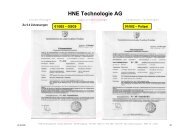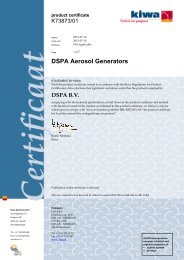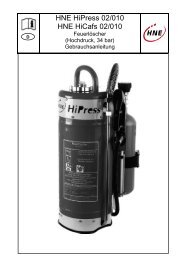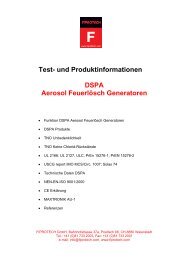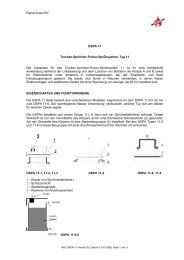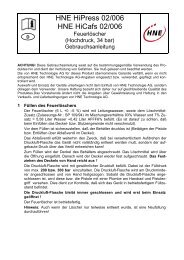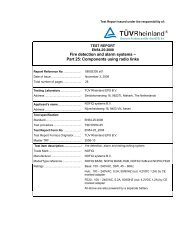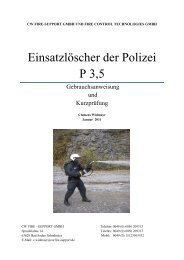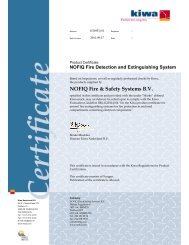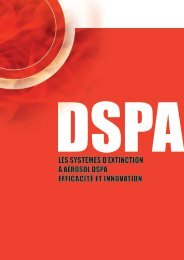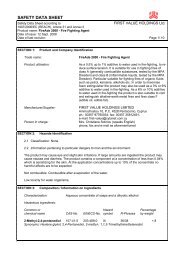FireAde 2000 Hydrocarbon suspension technology - Flame Guard
FireAde 2000 Hydrocarbon suspension technology - Flame Guard
FireAde 2000 Hydrocarbon suspension technology - Flame Guard
You also want an ePaper? Increase the reach of your titles
YUMPU automatically turns print PDFs into web optimized ePapers that Google loves.
6<br />
®<br />
Foams in fire classes A and B<br />
The foam method of fighting a fire is based on two<br />
operating principles:<br />
1. Reducing the surface tension<br />
As is the case with the wetting agents, foam also<br />
reduces the surface tension of the water. This<br />
characteristic supports the formation of bubbles and<br />
the expansion of the foam film over the surface of<br />
the thermal load.<br />
The technically mature alternative<br />
<strong>FireAde</strong> <strong>2000</strong> – fighting fires<br />
with <strong>suspension</strong> <strong>technology</strong><br />
The method of fighting fires by separation is based<br />
on five basic operating principles:<br />
1 Reducing the surface tension of the water<br />
2 Rapid heat reduction<br />
3 Interrupting the chain reaction<br />
of the free radicals<br />
4 Formation of a foam film<br />
5 Neutralisation of the Hydro Carbon molecules<br />
On 1) Reducing the surface tension of the water<br />
As is the case with the wetting agent, the surface<br />
tension of the water is reduced from 72 dyn/cm 2<br />
to less than 22 to 26 dyn/cm 2 , depending on the<br />
water used. During fire fighting, this effect has the<br />
same advantages as the use of a wetting agent in<br />
comparison with ordinary water.<br />
By reducing the surface tension, the size of the<br />
individual water droplets is reduced. A smaller water<br />
droplet size means a larger surface area relative to<br />
the volume. Heat dissipation is achieved by allowing<br />
the fire to come into contact with the water surface<br />
and removing energy by changing the state from<br />
liquid to gas.<br />
A larger surface area in proportion to the volume<br />
enables greater contact with the fire so that thermal<br />
energy is more rapidly absorbed even if the water<br />
volume remains constant. <strong>FireAde</strong> <strong>2000</strong> chemically<br />
reacts with the water, causing normal water to<br />
become up to 15 times “softer“, with the individual<br />
droplets becoming significantly smaller. The surface<br />
tension is significantly reduced.<br />
In addition, the water can be distributed more<br />
rapidly due to the reduced surface tension, so that a<br />
greater surface is dampened and the water can<br />
penetrate more deeply into the burning material.<br />
On 2) Rapid heat reduction<br />
Fire Ade <strong>2000</strong> improves the way in which the heat is<br />
channelled into the water droplets, thus resulting in<br />
The agent for all types of applications: <strong>FireAde</strong> <strong>2000</strong><br />
2. The formation and maintenance of a foam film<br />
The distinctive difference with wetting agents lies in<br />
the fact that foam is able to form bubbles that last<br />
longer (i.e. formation of a foam film over the<br />
thermal load). This isolates the thermal load from<br />
oxygen, cutting off the supply of oxygen required<br />
for the fire to burn.<br />
The covering capacity of the foams in fire classes A<br />
and B isolates the thermal load, which subsequently<br />
emits heat at a slower rate.<br />
Surface tension test<br />
According to US norm NFPA 18<br />
<strong>FireAde</strong> <strong>2000</strong> fulfils all the NFPA 18 directives for<br />
tests for class A and class B fires.<br />
Practical tests<br />
A simple test demonstrates how <strong>FireAde</strong> <strong>2000</strong><br />
improves the wetting and penetration capacity of<br />
water.<br />
10 cm 3 water are applied to blotting paper in a<br />
fixed position. The surface tension causes it to<br />
form a pool of approximately 50 mm 2 .<br />
When a 3% mixture of water and <strong>FireAde</strong> <strong>2000</strong> is<br />
used and 10 cm 3 water are applied in the same way,<br />
the surface tension of the water is reduced to such<br />
an extent that the dampened surface immediately<br />
expands to more than 600 mm 2 as the smaller<br />
droplet size causes the mixture to penetrate the<br />
paper instead of forming a pool.<br />
a significantly higher evaporation rate. In addition,<br />
existing Hydro Carbon molecules are attracted to<br />
this <strong>FireAde</strong> <strong>2000</strong> / water compound by its electrical<br />
charge. These characteristics of the <strong>FireAde</strong> <strong>2000</strong> /<br />
water mixture result in the mixture being almost<br />
entirely converted into water vapour which produces<br />
a very great cooling effect. These water vapour<br />
molecules combine with the adjoining water<br />
molecules and the water vapour condenses back<br />
into water. This cyclical change in the state within<br />
the water droplet, i.e. between evaporation and<br />
condensation, absorbs a great deal of heat energy,<br />
thus rapidly reducing the heat while at the same<br />
time creating little water vapour.<br />
In addition to the reduced surface tension, and thus<br />
to the increase in the surface/volume ratio, the




